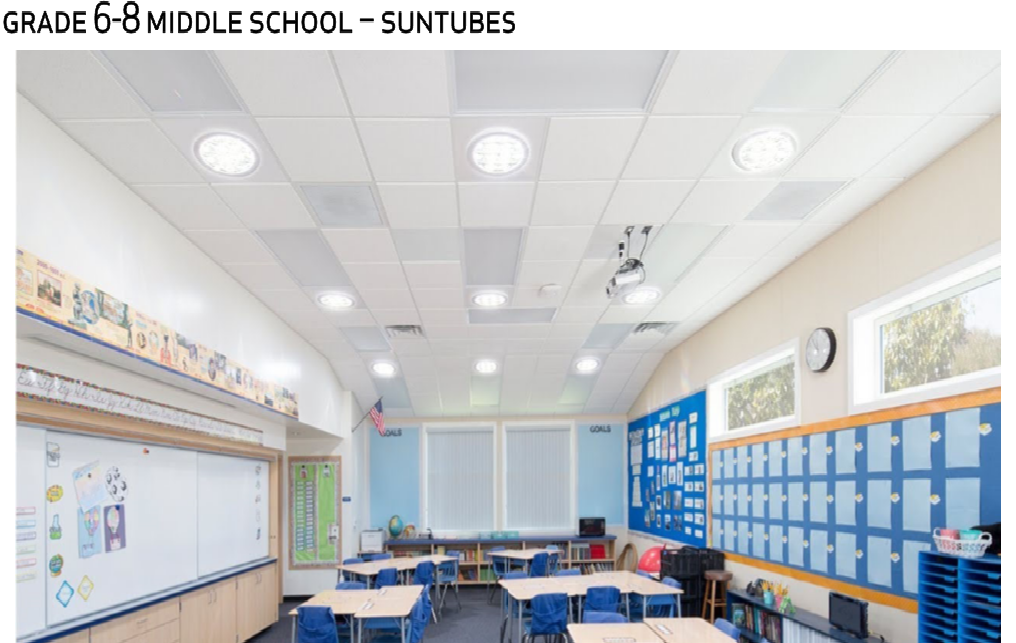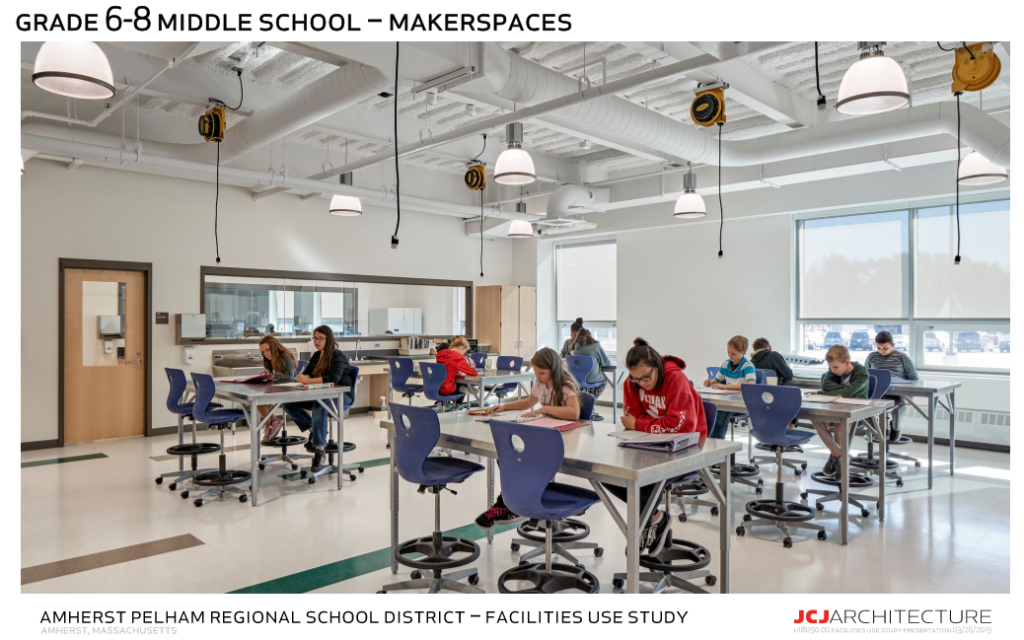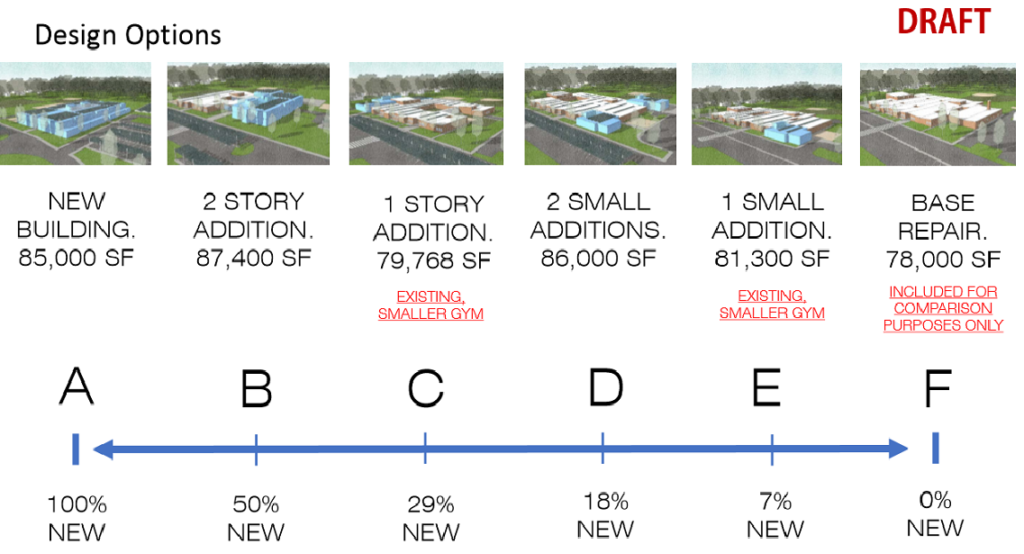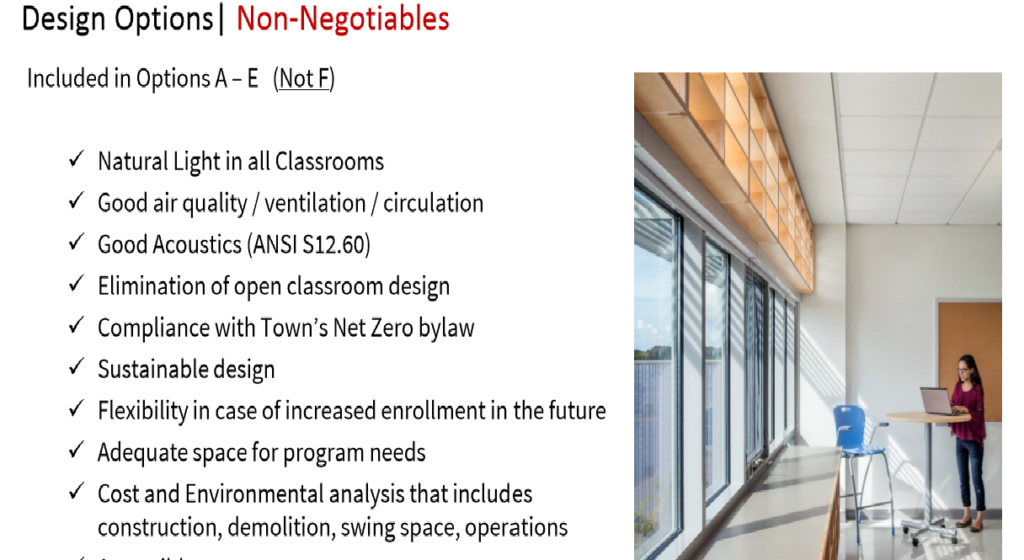AMHERST SEEKS STATE FUNDING TO REPLACE TWO ELEMENTARY SCHOOLS: Officials Cite Single, 600-Student Building as the “Proposed Framework”
by Marla Goldberg-Jamate
The Town of Amherst is submitting new applications to the state this month, seeking funds to renovate or replace the Fort River and Wildwood elementary schools. Meanwhile, many other ideas are percolating for the public schools, including shifting 6th graders to Amherst Regional Middle School, which is now just grades 7 and 8.
The Amherst Town Council voted unanimously on April 1 to approve sending new Statements of Interest (SOIs) to the Massachusetts School Building Authority (MSBA). The Council’s vote followed other unanimous votes in March 11 by the Amherst School Committee.
The applications for the two schools describe problems at the buildings with noise, climate control, and air quality, and outline a “proposed framework” for replacing them, with a single building for about 600 pupils in grades K-5 or K-6. The Fort River application is here, and the Wildwood application is here. Separate applications are required, but they have the same goals and, if one is funded and implemented, the other application would be withdrawn.
If Amherst is accepted into the state program, final decisions about the school size, grade configuration, and location would be made during a feasibility study and schematic design phases. Although both SOIs focus on the one-new-school proposal, MSBA procedures require that all options for school replacement be explored as part of the feasibility study, including renovation of the existing building for their current grade configuration and enrollment.
Any new construction would have to comply with Amherst’s Zero Energy Bylaw adopted in May 2018. That bylaw requires that all new town buildings and additions with over $2 million in construction costs operate with renewable energy sources and without fossil fuels, except for emergency power generators. The text of the bylaw is on page 100 here.
Fort River, which opened in 1973, now has 317 pupils and Wildwood (with identical floorplan), dating to 1970, has 424. Both schools are over 80,000 square feet in size. They initially had the completely open-classroom design that was popular at the time, although partial walls have been built since to help remedy problems that became quickly apparent with the fully-open model. In recent years district officials have cited heating and ventilation problems with both schools. (Fort River received two new gas boilers about nine years ago, and Wildwood a new oil boiler system this past summer.)
Amherst Town Meeting approved funds to study the Fort River roof in 2018. The study estimated that replacement would cost $1.9 million.
The district’s SOI for Fort River states that some teachers “developed asthma, multiple chemical sensitivities, allergies, and other health problems,” after working in the buildings for a long time. The Wildwood statement notes that Pioneer Valley residents suffer from a higher rate of asthma than the Massachusetts average.
Repeated testing has shown that areas of the buildings lack sufficient fresh air circulation, due in part to blocked or dirty vents, but that mold, bacteria, asbestos and radon are in acceptable ranges. At recent School Committee meetings, teachers spoke about roof leaks and rodent droppings.
The interest statements prioritize Fort River, although the School Committee has emphasized its wish to replace both schools simultaneously with one large school.
At the March 11 School Committee meeting, Ginny Hamilton, a Crocker Farm Elementary parent and co-chair of the Amherst Forward group, praised the plan and said she believes there is “near unanimous support” for it.
School Committee member Eric Nakajima described “hopefulness” about consensus for the plan, and said a community engagement process was beneficial. “It was inevitable that we would have questions…we know there are unknowns. We can manage them together…I think we can get it right,” he said at the March meeting.
However, committee member Kerry Spitzer said that a “small segment of the population” is not convinced that the single-large-school plan is the best one, adding that the committee should try to broaden the consensus.
There were 137 responses to an online feedback form, and 159 people attended listening sessions, some appearing at more than one, according to a report here. Although there were requests from some residents and from District Five Town Councilor Darcy DuMont, for a town-wide informational letter and survey. An online feedback form was shared by the district, but did not act on the other requests, citing time constraints and other concerns.
Nonetheless, some residents expressed a wish for the district to provide more information on options for replacing the schools.
“The six listening sessions focusing on one of the options – closing Fort River or Wildwood elementary schools and building a new 600-student school – simply did not provide enough information to evaluate it,” residents Andrea Battle, Janet McGowan, and Demetria Shabazz wrote in a guest column for the Amherst Bulletin.
The state’s application deadline is April 12, and the town will be notified about whether it has been accepted into the possible funding pipeline in December.
The single-school plan, put forward by School Superintendent Michael Morris in the last few months. Watch the video of his presentation here.
Possible Movement of 6th Graders to the Middle School
Limiting a new building to just 600 pupils could require a shift of 6th graders townwide to Amherst Regional Middle School (ARMS), Morris has said. The idea was explored in recent months in the Regional Master Facilities Use Study. The analysis found that ARMS, which has nearly 200,000 square feet, can readily accommodate up to 150 additional children. A variety of scenarios are being considered, including a no-cost plan which would put the 6th graders into second-floor classrooms in a separate hallway from 7th and 8th graders. Other scenarios call for improvements to ARMS, including renovations to improve entrance security and turn part of an old machine shop into a new “maker space.” A more substantive renovation of ARMS could create a 6th-grade classroom wing on the first floor at a cost of approximately $20 million. See a report on the study’s findings here.


Questions remain about whether Pelham, Leverett, and Shutesbury, which now send children to ARMS starting in 7th grade, would want to send 6th graders as well. Talks are ongoing about the prospect of full regionalization with Pelham, and possible future use of the Pelham Elementary School building. The Amherst and Pelham Regional School District Planning Board next meets on April 10, and the agenda is here.
The site for a potential new consolidated Amherst elementary school would be established during the Feasibility Study. The Wildwood site was the proposed location for the former school building project, which failed to win a two-thirds majority needed from Town Meeting to authorize borrowing. That project called for a 750-student building for grades 2 through 6, which would have been divided into two separate “co-located” schools. The Fort River site has now been evaluated as part of the Fort River feasibility study (see below).
Town property maps show the Wildwood site has about 14 acres, and the Fort River site has 11.75 acres, although buildable acres at each depend on features of the sites, and the shape and size of any new building.
Funds Sought to Study Crocker Farm Expansion
On March 28, Crocker Farm parent Maria Kopicki, who is vice chair of the Fort River School Building Committee, and Wildwood parent Toni Cunningham presented a “resident capital request” to the Town’s Joint Capital Planning Committee. They asked the Town to earmark $40,000 for a “Crocker Farm Expansion Analysis Study.”
Kopicki and Cunningham said the Town needs to find out if there is room on the Crocker Farm site for expansion, and if so, of what size. If Fort River and Wildwood were replaced with a single school and 6th grade did not move to ARMS, an expansion of Crocker Farm would be needed to keep the enrollment of the new school to 600 students, they said. Citing concerns raised at the Listening Sessions about lack of parity and large school size, Kopicki and Cunningham also recommended assessing the potential for equal-sized schools of 480 students if 6th grade does move to ARMS. A video of the presentation is here.
Fort River Site Found To Be Buildable
Over the last year and a half, the Fort River School Building Committee (FRSBC) has been studying improvement options solely for Fort River. At an April 3 meeting, there was extensive discussion about the fact that the site is buildable, and how to convey that information clearly in an upcoming report.
The FRSBC has explored six options for that school, including completely new construction and varying degrees of demolition, renovations, and additions. A presentation on those options is here.


They include enrollments ranging from the current 315 Fort River pupils to 465. The higher number was set due to the upcoming dual-language Spanish/English immersion program at Fort River, plus three preschool classrooms.
Building Authority Reportedly Awaits Readiness and Consensus in Amherst
The Amherst School Committee conducted several “listening sessions” about the single-school Fort River and Wildwood replacement plan in March, and Morris has said those sessions were successful.
“I do think it is a model that we plan to build on,” he said at the March 11 meeting. “These kinds of interactive dialogues are incredibly important.”
A report on those listening sessions is here.
Morris proposed what he called the “consensus” plan after Amherst learned in December that its application to the MSBA from the previous year had not been accepted.
In January, Morris told the School Committee that he called the MSBA to find out how to improve Amherst’s chance of success with future applications. The town’s “state of readiness” was a factor in its 2018 rejection by the state, Morris said, adding that the MSBA wanted to know that Amherst had reached a “consensus,” about the type and number of schools it wanted. A lack of consensus would jeopardize Amherst’s future chances with the MSBA, Morris warned. The MSBA did not issue any written statement confirming the conversation Morris reported with the agency.
At a later meeting, Morris outlined the 600-student, single-building plan, and proposed that the grade configuration be K-5 or K-6. Morris cited strong opposition to the more extensive grade reconfiguration called for in the failed plan, which would have converted Crocker Farm in South Amherst to a town-wide preschool, kindergarten, and 1st grade building, with all children in grades 2-6 on the Wildwood site. Many concerns were raised about that plan, including apprehensions about the large size, to transportation logistics, and concerns about splitting young siblings between schools.
At the April 1 Town Council meeting, District Three Councilor Dorothy Pam said that Morris’ 600-student plan would yield a smaller school than was previously proposed, with a longer grade span enabling more siblings to attend school together. However, the Council’s affirmative vote was to submit the interest statements, and not specifically on Morris’ proposed framework.
